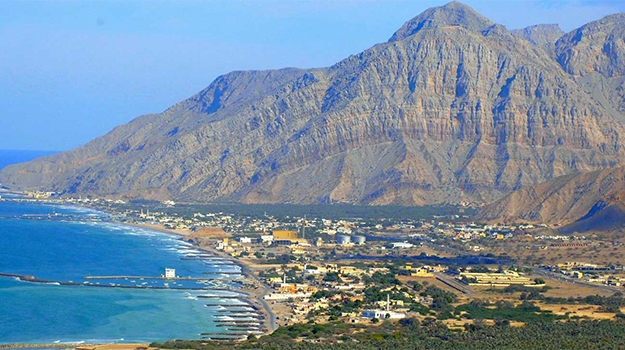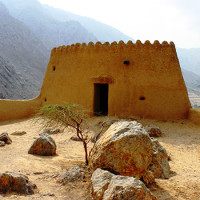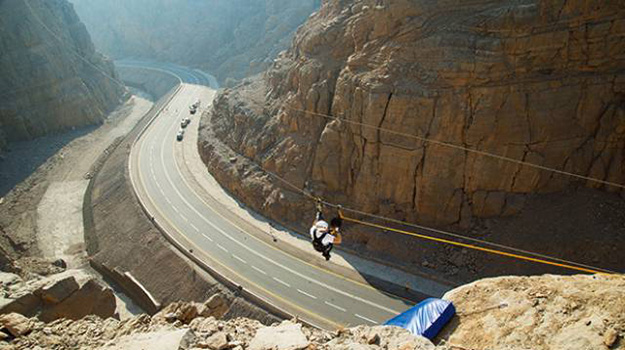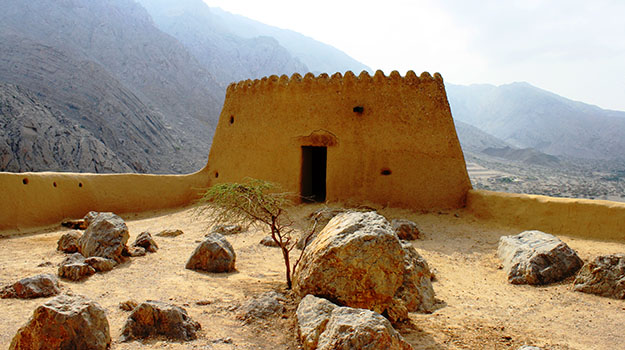Historically known for its cultural, political and commercial infrastructure, Ras Al Khaimah (literally meaning top of the tent) is the fourth largest emirate forming the UAE. Best known for its rich and varied heritage, RAK boasts of a glorious naval past while continuing to be an important trading center in the region even today.
RAK has quite a varied landscape in comparison to the rest of the country boasting of sixty five kilometers of coastline along the Gulf, fertile plains, mountains which reach up to 1900 m and deserts.
This picturesque emirate is divided by a creek with lush mangrove forest along the creek banks. Scattered throughout the town are pretty roundabouts with quaint structures, each reflective of the traditions. Particularly interesting are the Pearl Oyster R/A, Lantern R/A (in local language and hence easily identifiable) which represents the fishing and pearling industry that thrived in the region in the past.
While the western part of the City (or old RAK) houses the government departments, educational institutions, shopping malls, hotels, residential areas and new construction projects, the eastern part, known as Al Nakheel, houses the Emiri Court, some government departments, markets, Ras Al Khaimah Exhibition Center, hospitals and residential areas. This is also the area where the majority of the city’s population lives. The two parts of the city are linked by a bridge and a network of modern roads.
Alternate acceptable names for Ras al-Khaimah include Ra’sal-Khaymah; Rā’s al Ḫaima or simply RAK.
Geography
Ras Al Khaimah is located at the north end Arabian Gulf nestling between the Hajar Mountains on the east and Arabian Gulf on the West and shares mountainous borders with the Sultanate of Oman, Umm-Al-Quwain, Sharjah and Fujairah. This Top-of-the-Tent emirate is positioned near the Straits of Hormuz is the gateway to Musandam.
Important towns, settlements and areas–
Al Jazira Al Hamra: An old coastal town with numerous real estate projects and industrial zone known for having the best preserved traditional fisherman village in the UAE. However plenty of new developments have taken place in the areas including the Ice Land Water Park and industrial zones.
Al Rams: Atypical fishing and pearl diving coastal town, Al Rams, a small town has a rich tradition and culture. Small harbours, beaches and bird-watching spots are the main attractions of this place.
Al Shams: A small town near the border with Oman. Interesting old wadi-settlements, rock engravings and harbour make this a place worth visiting.
Diqdaqah: A village known for agriculture and dairy/poultry farms.
Khawr Khuwayr: An industrial zone, with the largest port in Ras al-Khaimah and numerous companies such as a cement factory
Khatt: A tiny village surrounded by mountains and popular among the locals and expats for its thermal springs and palm gardens.
Masafi: A town in the south, on the border with Fujairah famous for its natural springs and the popular brand of water named Masafi.
HISTORY
What is known today as Ras Al Khaimah, was for centuries known as Julfar. Only in the 18th century, the name was changed to Ras Al Khaimah. In 1972, a year after UAE was formed, RAK joined the union.
Ras Al Khaimah has been a very important site of human habitation for several millennia. Many historical and archaeological sites have been found throughout the emirate which dates back to different time periods, including those of the Umm an Nar culture (3rd millennium BC). Archaeological evidence has shown that the settlement earlier known as Julfar shifted locations depending on the silting up of harbour channels. Excavations over the recent years has revealed the remnants of a Sassanid era fortification indicating that early Julfar was located in the Shamal area, not far from other sites of historical/archaeological interest such as Sheba’s Palace and the largest Umm an-Nar tombs found on the Arabian Peninsula. Julfar was also believed to tbe inhabited by the Azd (a branch of the Kahlan tribe) during the eighth and ninth centuries AD, and that the houses of the Azd were built of wood.
After British occupation (18 December 1819 – July 1821), in 1822, Sheikh Sultan bin Saqr Al Qasimi signed the General Maritime Treaty of 1820 with Britain, accepting a protectorate and like other emirates such as Ajman Dubai, Umm Al Quwain and Sharjah, it occupies an important on the sea route to India making it important enough to be recognized as a salute state.
In 1869, Ras al-Khaimah became fully independent from neighbouring Sharjah. However, from September 1900 to 7 July 1921, it was re-incorporated into Sharjah; the last governor became its next independent ruler. On February 11, 1972, Ras al-Khaimah, joined the United Arab Emirates.
ECONOMY AND DEVELOPMENT
Located at the crossroads of trade and commerce between East and West, RAK is ideally positioned to service and access the Middle East, Africa, Indian Subcontinent and the CIS markets, earning itself the reputation as the commercial center with innovative, dynamic and entrepreneurial business culture. To capitalize this advantage, RAK is developing a world class infrastructure, air and port facilities to accommodate the growing industry and trade.
Sustained growth and wealth creation has continued over the past few years. Although RAK does not have the abundance of hydrocarbons as some of its UAE neighbors and in the region, it has established itself as a robust economy with an increasingly diversified base using it’s
natural topography for commercial and industrial projects and green belt in the southern side for agricultural purposes. Rich in natural beauty and wealth, its unique location and business strategies has aided in the economic development mainly in two sectors – tourism and industry.
This emirate witnessed rapid developments in the last two decades, particularly in the fields of commerce & education under the patronage of His Highness Sheikh Saqr Bin Mohammed Al Qassimi. A strong economy, together with a stable political environment makes Ras Al Khaimah a logical place to invest.
The cost of living and doing business in RAK are markedly lower than other emirates.
Industries
RAK does not produce oil, focusing instead on developing its industrial sector. Today, the emirate is home to many national institutions, government agencies, and international companies. Ras al-Khaimah’s ever-growing business community has been noticed globally, regionally, and nationally. The emirate is rapidly emerging as an investment destination.





